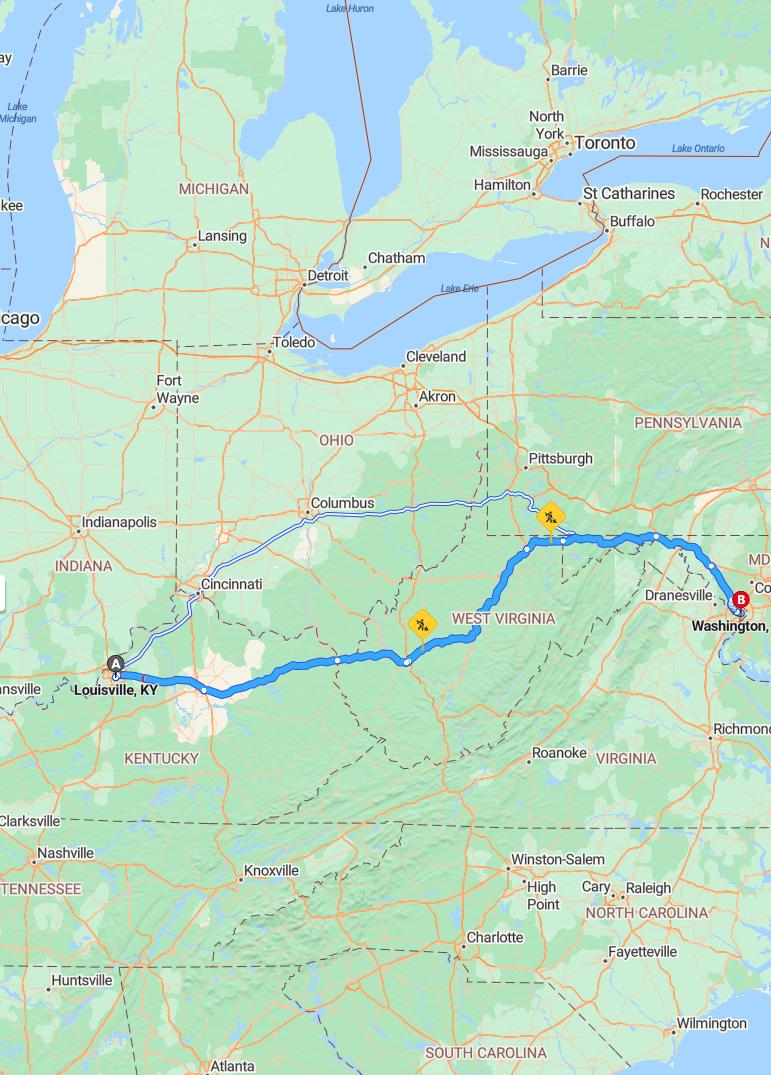Distance and estimated driving time
Driving from Louisville to Washington covers approximately 600 miles via I-64 E and I-79 N, with an estimated travel time of around 8 hours and 53 minutes. This route takes travelers through scenic eastern states, offering a relatively straightforward interstate journey. It's advisable to plan for rest stops and potential traffic delays to ensure a smooth trip. Preparing ahead with navigation updates and service station locations can help optimize travel efficiency and comfort.
Driving route
Traveling from Louisville, KY, to Washington, DC, offers a scenic and diverse journey through several major cities and regions. Starting in Louisville, you will pass through Cincinnati, known for its vibrant arts scene and historic architecture. Continuing northeast, Columbus provides a bustling urban environment with numerous cultural attractions and parks. As you traverse West Virginia, you'll experience the scenic Appalachian landscapes that characterize this mountainous state. Finally, reaching Washington, DC, you arrive in the nation's capital, rich with historic landmarks, political institutions, and a dynamic cultural scene.

Traffic conditions and peak hours
Traveling from Louisville to Washington, DC, typically involves navigating through several major metropolitan areas, which can experience significant traffic congestion during peak hours. In Cincinnati and Columbus, rush hour usually occurs between 7:00 AM and 9:00 AM, and again from 4:00 PM to 7:00 PM, potentially causing delays on the highways. West Virginia generally has lighter traffic volumes, but travelers should remain cautious of construction zones and weather-related disruptions. When approaching Washington, DC, peak traffic hours are generally from 6:30 AM to 9:30 AM and 3:30 PM to 7:00 PM, so planning your trip outside these windows can help ensure a smoother journey.
Route alternatives and scenic options
Traveling from Louisville to Washington, D.C., offers several route alternatives and scenic options for travelers seeking variety. The most direct route typically follows I-71 North to Cincinnati, then merges onto I-70 East through Ohio and West Virginia before reaching the capital. For a more scenic experience, travelers can choose to detour through Cincinnati's riverfront neighborhoods or traverse the scenic Appalachian foothills in West Virginia. Alternatively, taking route 50 or exploring smaller highways through rural Ohio can provide picturesque views and a more leisurely journey, enriching the road trip with diverse landscapes.
Rest stops and service areas
When traveling from Louisville to Washington, DC, drivers will find several convenient rest stops and service areas along the route. In Cincinnati, there are numerous roadside options offering fuel, food, and restrooms, making it easy to take a quick break. As you pass through Columbus and West Virginia, designated service areas provide amenities such as gas stations, parking, and comfortable rest zones for travelers. Approaching Washington, DC, it's advisable to plan your stops in advance, utilizing rest areas adjacent to major highways to ensure a safe and relaxed journey.
Weather forecast along the route
Traveling from Louisville to Washington, DC, travelers can expect varied weather conditions along the route. In Louisville and Cincinnati, mostly mild temperatures with occasional rain showers are forecasted, making for potentially wet driving conditions. As you pass through Columbus, the weather is predicted to remain relatively stable with partly cloudy skies, providing some relief for drivers. Approaching West Virginia and finally reaching Washington, DC, the forecast indicates a slight drop in temperatures with possible fog in the early morning hours, so caution is advised for safe navigation throughout the journey.
Vehicle maintenance tips for long drives
Before embarking on a long road trip from Louisville to Washington, it's essential to ensure your vehicle is properly maintained. Check tire pressure and tread depth to prevent blowouts and improve fuel efficiency, and top off all fluid levels, including oil, coolant, and windshield washer fluid. Inspect your brakes and ensure your battery is in good condition to avoid unexpected breakdowns. Additionally, carry an emergency kit with essentials like a spare tire, jumper cables, and basic tools to handle any unforeseen issues during your journey.
Parking options in Washington
Washington, DC offers a variety of parking options to suit visitors' needs. There are numerous public parking garages and lots located throughout the city, particularly near popular attractions and government buildings. Street parking is available in many neighborhoods, but drivers should pay attention to parking restrictions and resident permit requirements. For added convenience, many visitors opt for nearby parking apps or reserved parking services to secure a spot ahead of time.
Local traffic regulations and laws
When driving from Louisville to Washington, D.C., it is essential to be aware of local traffic regulations and laws that vary across states. Kentucky, Ohio, West Virginia, and D.C. each have specific speed limits, rules regarding seat belts, and regulations on the use of mobile devices while driving. Additionally, tolls may be encountered on certain highways, and different enforcement practices can apply, such as stricter DUI laws in D.C. Staying informed about these regional traffic laws helps ensure a safe and legal journey through each jurisdiction.
Safety tips for cross-state driving
When embarking on a cross-state drive from Louisville to Washington, it is essential to prioritize safety at all times. Ensure your vehicle is well-maintained, including checking tire pressure, brakes, and fluid levels before starting the journey. Stay alert and take regular breaks, especially when passing through multiple states like Ohio and West Virginia, to prevent fatigue. Additionally, adhere to speed limits, keep a safe following distance, and be mindful of changing weather conditions and local traffic laws across different regions.
